Entries in wind turbine eagles (3)
1/22/12 Wind company wants permission to kill golden and bald eagles, says the only reason endangered eagles are in the area is because of baiting by rural residents. USFWS disagrees.
Video of eagles in footprint of proposed wind project, Goodhue County, Minnesota
DNR, U.S. FISH & WILDLIFE CRITICIZE GOODHUE COUNTY WIND PROJECT
By Brett Boese
via The Post-Bulletin, Rochester MN, postbulletin.com
Jan 20, 2012,
ST. PAUL — The Minnesota Public Utilities Commission has set the public hearing Feb. 2 for the Avian and Bat Protection Plan associated with the AWA Goodhue wind project.
The news was released Friday, one day after the Minnesota Department of Natural Resources and the U.S. Fish and Wildlife Service filed separate paperwork challenging or disputing portions of the 127-page ABPP.
Approval of the plan is the final permitting hurdle National Wind, the project developer, must clear before it can begin constructing the 78-megawatt project; it has targeted June to break ground. The process, which includes a legal appeal proceeding concurrently, has taken almost three years.
The bird-and-bat plan, which was finalized in December and is among the first of its kind, has become the latest target of criticism.
Concerns registered
A 12-page report by the USFWS and the five-page document from DNR that were posted to the PUC docket Thursday echo concerns that have been voiced for months by citizens, since Westwood Professional Services, the environmental agency hired by National Wind, identified no bald eagle activity within the project footprint in its initial report filed to the PUC in 2010.
“It’s almost like there might be a showdown between the DNR and (U.S.) Fish and Wildlife and Westwood,” said Rochester’s Mary Hartman, a project critic who has been the catalyst in identifying and verifying six to seven active bald eagle nests within the project footprint. “We were really well represented by the U.S. Fish and Wildlife and the DNR. (It shows) our information was fair and accurate.”
Though officials from the DNR and USFWS did not return calls on Friday, both agencies appear to have issues with many of the plans and claims developed in National Wind’s document. For example, the plan specifically states that the USFWS has no recommendations for avoiding and minimizing impacts from wind turbines on bald eagle nests. In response, the service cited a 2003 guide that calls for a minimum two-mile setback from bald eagle nests and another document from 2007 that contains “explicit spatial buffer recommendations” around bald eagle nests and important eagle use areas.
Issues with eagles
Both agencies also took issue with how the ABPP used eagle baiting allegations to explain increased avian activity in the project footprint. National Wind claims its point count surveys have been “seriously compromised by an active baiting program being conducted by project opponents.” However, no landowner has been cited for baiting and the Minnesota Board of Animal Health has not drawn any correlation between carcass disposal and increased bald eagle activity.
“The service recommends AWA Wind analyzes the data they have collected, rather than attempt to extrapolate potential data,” wrote Tony Sullins, USFWS field supervisor.
Turbine shut downs were also recommended as a potential mitigation plan, while calls for clarification and more data were common — though bald eagle issues were most prevalent.
Across the United States, five bald eagle deaths have been reported in wind projects. The USFWS says information on those incidents cannot be shared because most are tied up in litigation.
It’s unclear if public comment will be allowed at the Feb. 2 PUC hearing. A PUC spokesman did not return calls on Friday.
Minnesota Public Utilities Commission meeting: 121 E. Seventh Place, Suite 350, St. Paul, 9:30 a.m. Feb. 2.
11/21/11 Fragmented farmfields in WeEnergies new wind project AND How do you UN-sign on the dotted line? Farmers want out of wind developer's contracts
The photos below were taken by Jim Bembinster. They show how farmfields have been fragmented by wind turbines and access roads in WeEnergie's Columbia County wind project. What they don't show is the compaction of the soil from heavy machinery. Compacted soil affects crop production. Contracts signed by farmers in this project gives WeEnergies the right to site the turbines as they see fit.
CLICK HERE To read about a farmer whose land was leased to WeEnergies for this project and what has happened to his life and his farm since then.
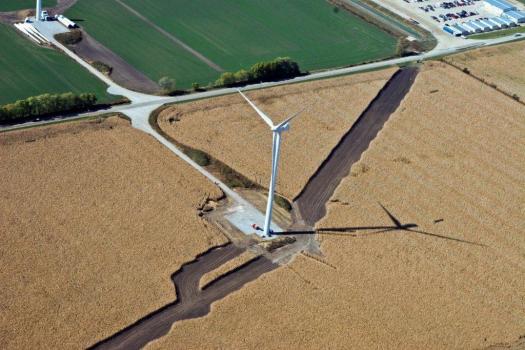
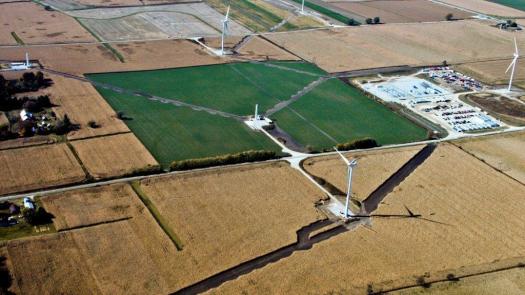
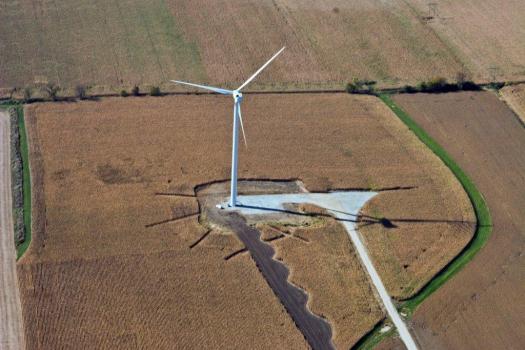
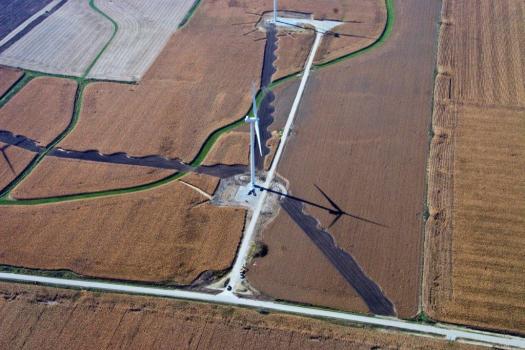
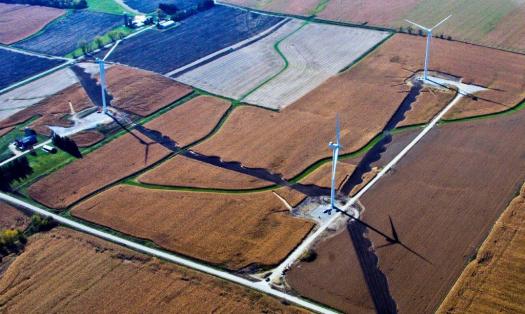
From Minnesota:
SEVERAL LOCAL LANDOWNERS WANT OUT OF WIND CONTRACT
By Regan Carstensen,
SOURCE The Republican Eagle, www.republican-eagle.com
November 21, 2011
“Those landowners a lot of times are making decisions based on what the wind folks are saying,” said Jaime Edwards of the Minnesota Department of Natural Resources. “If they had both sides of the story, they may not have signed the contracts.”
AWA Goodhue Wind has faced many battles in its journey toward getting a permit for a wind farm in Goodhue County, and another one is about to ensue.
A handful of participating landowners who agreed to be part of the 78-megawatt wind farm are now anxious to get out of their contracts and have sent what they call a letter of termination to AWA Goodhue.
AWA Goodhue officials declined to comment.
In addition to a long list of other reasons, the landowners — who asked not to be identified — said realizations about possible effects on the area’s wildlife caused them to want out of the project.
“Those landowners a lot of times are making decisions based on what the wind folks are saying,” said Jaime Edwards of the Minnesota Department of Natural Resources. “If they had both sides of the story, they may not have signed the contracts.”
Mary Hartman, a Rochester resident, has been monitoring the project footprint because she’s concerned about the area’s ecosystem and how it will be affected by more than 45 wind turbines.
Hartman has been in contact with some of the landowners who are looking to void their contracts, and she said she has been helping them see how she thinks a wind farm could be putting migratory birds — especially eagles — in harm’s way.
“The people who signed didn’t necessarily know that they had to be concerned about this,” Hartman said.
She said that the topography of land — including the rolling terrain and proximity to water — within the project footprint is ideal for eagles and allows them to soar on warm wind currents in the valleys. But Hartman is worried the construction of a wind farm might disrupt their usual flight paths.
“When they want to come out of the ridge, if they’re surrounded by wind turbines they’re going to get hit,” she explained.
DNR officials share Hartman’s concerns.
“It’s nice to try to use alternative energy, but we are right on the Mississippi Flyway,” Edwards said. “You really have to look hard at whether something like this should be placed on a flyway.”
Edwards also said that although the project has fewer than 50 turbines planned, once one moves in, she expects more are likely to follow.
“It’s the American way — if one wind turbine is good, then 200 must be better,” she explained. “But is it really?”
Edwards traveled out to and studied the project footprint in order to provide assessments of any potential impacts to the non-game wildlife there.
Hartman also has had her fair share of bird watching in Belle Creek Township, including a time she pointed out eagles’ nests to officials at Westwood Professional Services, a company that AWA Goodhue hired to assess the project’s impacts on the environment.
Westwood’s technical director of environmental services, Ron Peterson, compiled a report in June about observations he made with Hartman in May, and concluded there were many fewer eagles and nests in the area than she had seen.
He reported that of the 12 nests Hartman said she had previously observed, six did not exist, one was abandoned, one was new but in an uncharacteristic location, three had been previously recognized by Westwood and one was a duplicate reference to an already known nest.
During her most recent trip to Belle Creek Township on Wednesday, Hartman said she saw more than 15 bald eagles in the project footprint. And although the likelihood of seeing them is higher now that it is migration season, Edwards of the DNR said the eagles would be hard to miss at other times of the year as well.
“There’s no way that you cannot see eagles in that area. They were all over the place,” Edwards said of the numerous times she’s studied the area.
In addition to the research done by the DNR, U.S. Fish and Wildlife Service has done studies of the project footprint and made recommendations to AWA Goodhue on how to best avoid negative impacts to the birds.
USFWS can’t do much beyond those suggestions.
“We can’t bring enforcement against anybody until there’s a documented take of a migratory bird or an eagle,” Rich Davis of USFWS explained.
Davis said AWA Goodhue has not applied for an incidental take permit. Without the permit, the company could face a significant fine upon the death of an eagle from a wind turbine collision.
“If they are actually prosecuted for that and found guilty of the take from their project, they would not be eligible to pursue (an incidental take) permit in the future,” he said.
Any additional eagle deaths from wind turbines would result in more substantial fines, Davis said.
7/26/11 Wind developers VS Eagles in Minnesota: How green is a Eagle killing machine?
FROM MINNESOTA

DEBATE GROWS OVER WIND TURBINES IN THE PATH OF EAGLES
READ ENTIRE ARTICLE AT THE SOURCE: KARE11.com
July 26, 2011
By Trisha Volpe
GOODHUE COUNTY, Minn. -- Next to the crops, an environmental debate is growing in Goodhue County farm country - green energy on one side and saving wildlife on the other.
"Like a lot of farmers in the area, it's pretty deep in tradition," says local dairy farmer Bruce McNamara.
The McNamara farm has been in the area for 60 years. Bruce and his wife Marie are now worried about what could happen to their land and the birds they share it with, when a wind turbine project moves forward.
"Energy facilities should be sited in an orderly manner and they're clustered right over eagles' nests," says Marie, who is also a member of a local citizens group against a project to build wind turbines in the area.
The developer, AWA Goodhue Wind, plans to build 50 to 60 wind turbines over several thousand acres. Some residents and the U.S. Fish and Wildlife Service are concerned the turbines will interfere with eagles nesting and feeding. There are at least four confirmed nests in the area according to fish and wildlife officials.
"The issue we're more concerned about is the birds flying into them and being killed," says Mags Rheude of the U.S. Fish and Wildlife Service.
The developer says it's done everything possible to protect the eagles and doesn't believe their travel patterns bring the birds in the path of the turbines. The company has conducted several environmental studies, many still ongoing.
"We're probably 150 hours field time watching and monitoring eagle movements," says Ron Peterson, Director of Environmental Services for Westwood, the environmental consultant working with Goodhue.
Company officials say the issue may be about more than just eagles. Many landowners have bought into the project and turbines will be located on their farms.
"People who aren't participating or benefitting financially... don't want to look at them or listen to them if they're close enough to them," says Peterson.
The project has the go-ahead from the Public Utilities Commission, but in order to receive its permit Goodhue Wind has to conduct more studies and come up with a bird and bat management plan.
Goodhue hopes to start construction on the turbines by the end of the year.
The U.S. Fish and Wildlife Service is recommending a two mile buffer zone between turbines and the eagles.
NOTE FROM THE BPWI RESEARCH NERD:
The photo below was found on the Westwood Land and Energy Development Consultants website where the 'company biologist' Ron Peterson (mentioned in the previous article) is said to work. Wind companies often employ the services of one-stop-shopping 'consulting' firms like Westwood. The caption for the photo below reads: "We've been dancing through the years!"
Photo from Westwood Land and Energy Website